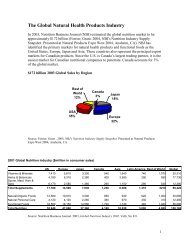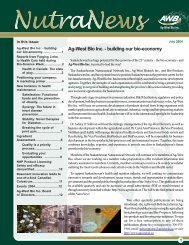Beyond Borders: Global biotechnology report 2010
Beyond Borders: Global biotechnology report 2010
Beyond Borders: Global biotechnology report 2010
Create successful ePaper yourself
Turn your PDF publications into a flip-book with our unique Google optimized e-Paper software.
Financial performance<br />
A transformational year<br />
It is fair to say that 2009 has been a<br />
year like few others. Around the world,<br />
companies, households and governments<br />
struggled as they were buffeted by the<br />
deepest recession in more than seven<br />
decades. The <strong>biotechnology</strong> industry was<br />
not immune to these developments, and the<br />
economic crisis had a palpable impact on<br />
the sector’s financial performance.<br />
For both the global economy and the<br />
global biotech industry, the impact was<br />
not uniform. Indeed, the emerging biotech<br />
sectors in China and India — two countries<br />
that continued to grow even as most<br />
economies slipped into recession — were not<br />
negatively impacted by the downturn.<br />
This article, and the rest of this section<br />
of <strong>Beyond</strong> borders, focuses on the<br />
performance of the biotech industry in<br />
the world’s established biotech centers:<br />
the US, Europe, Canada and Australia.<br />
The industry’s performance in emerging<br />
markets, including China and India, is<br />
discussed in the Country profiles section.<br />
(Since biotech sectors are still emerging<br />
in these markets, our discussion of them<br />
differs from the one here in relying on both<br />
qualitative and quantitative indicators.)<br />
Across the four major biotech centers,<br />
the business environment became<br />
considerably more challenging in 2009.<br />
While the industry raised healthy amounts<br />
of capital in aggregate, the stark reality<br />
that many biotech companies face in the<br />
“new normal” is that funding is harder to<br />
come by. Venture capitalists have become<br />
more discriminating, and the IPO markets<br />
have largely been closed to new companies<br />
seeking to raise funds from public investors.<br />
(For more on the financing picture, see the<br />
Financing article, “A higher bar.”)<br />
While all companies need capital, there<br />
are few businesses that have biotech’s<br />
combination of huge capital needs and<br />
long paths to commercial sustainability.<br />
Many biotech companies have therefore<br />
had to take strong measures to survive.<br />
To raise funds and reduce cash burn, large<br />
numbers of firms have restructured their<br />
businesses, laid off workers, sold noncore<br />
assets and shelved R&D projects.<br />
In many cases, this has also included<br />
Growth in established <strong>biotechnology</strong> centers, 2008–09 (US$b)<br />
Public company data<br />
Source: Ernst & Young<br />
2009 financials largely represent data from 1 January 2009 through 31 December 2009.<br />
2008 financials largely represent data from 1 January 2008 through 31 December 2008.<br />
Numbers may appear inconsistent because of rounding.<br />
2009 2008 % change<br />
Revenues 79.1 86.8 -9%<br />
R&D expense 22.6 28.7 -21%<br />
Net income (loss) 3.7 (1.8) -314%<br />
Number of employees 176,210 186,820 -6%<br />
Number of companies<br />
Public companies 622 700 -11%<br />
54 <strong>Beyond</strong> borders <strong>Global</strong> <strong>biotechnology</strong> <strong>report</strong> <strong>2010</strong><br />
increased reliance on conducting R&D<br />
or manufacturing activities in lower-cost<br />
locations. While the potential cost savings<br />
from such measures can be attractive,<br />
companies consider a variety of strategic<br />
factors when making location decisions. The<br />
tax implications of cross-border operations,<br />
for instance, are discussed in A closer look<br />
on the following page.<br />
If the biotech industry is unique in its<br />
capital needs, it is also unique in its ability<br />
to survive capital droughts. Biotech<br />
companies — and the serial entrepreneurs<br />
frequently at their helm — have survived<br />
several funding famines by responding<br />
creatively to shifting market conditions.<br />
Given the depth and systemic reach of<br />
this recession, however, many observers<br />
expected a sharp drop in the number of<br />
companies. So far, those fears have largely<br />
not been borne out. While we expect<br />
continued attrition and the lack of a robust<br />
IPO market to further trim the ranks of<br />
biotech companies in the year ahead,<br />
the reduction in the number of public<br />
companies in 2009 was not as significant<br />
as anticipated. There were 622 public<br />
biotech companies in the established<br />
biotech centers as of December 2009,<br />
compared to 700 a year earlier — an 11%<br />
decline, well short of the 25%–33% decrease<br />
that many analysts were expecting.<br />
The global recession did, however, have a<br />
more immediate impact on the financial<br />
results of public biotech companies. Across<br />
the four established biotech centers,<br />
the numbers (and the story behind the<br />
numbers) were remarkably consistent. The<br />
first of these impacts was on the top line<br />
of the income statement. The industry’s<br />
revenues fell by 9%, from US$86.8 billion in<br />
2008 to US$79.1 billion in 2009. However,








